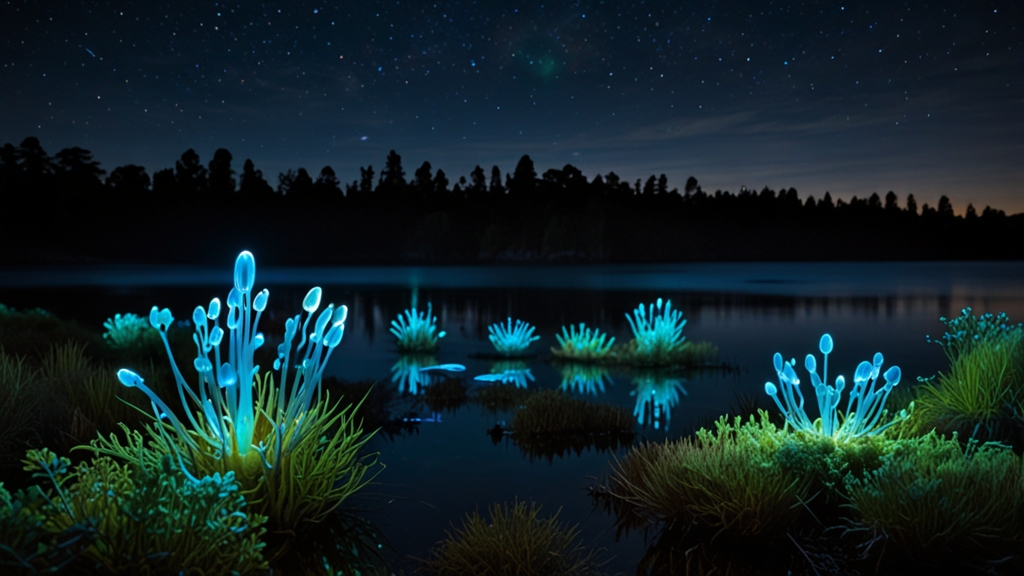The Amazing World of Bioluminescence: Nature's Night Lights
Imagine a world where, instead of artificial lights, the natural glow of living organisms illuminates the night. This is the incredible reality of bioluminescence—nature's way of producing light. From the depths of the ocean to the darkest forests, bioluminescence transforms the ordinary into the extraordinary.
What is Bioluminescence?
Bioluminescence is the production and emission of light by a living organism. This phenomenon occurs through a chemical reaction that typically involves a light-emitting molecule (luciferin) and an enzyme (luciferase). When luciferin reacts with oxygen, catalyzed by luciferase, it produces light. This process is incredibly efficient, generating very little heat.
The Science Behind the Glow
While the light-producing molecules and enzymes may differ across species, the basic principles remain the same. In most cases, the luciferin molecule absorbs energy and then releases it in the form of light. This bioluminescent light can range from blue and green to yellow and red, depending on the type of luciferin and the chemical environment surrounding it.
"Bioluminescence is not just a beautiful phenomenon; it's a remarkable example of nature's ingenuity and efficiency."
Bioluminescence in Marine Life
One of the most stunning displays of bioluminescence can be found in the ocean, where countless species use light to survive and thrive. In the deep sea, where sunlight cannot penetrate, bioluminescence is often the only source of illumination. Creatures like the anglerfish, which uses a glowing lure to attract prey, and jellyfish, which emit light to startle predators, showcase the diverse uses of bioluminescence in marine environments.
Phytoplankton, tiny photosynthetic organisms, are responsible for another incredible display known as "milky seas." When disturbed, these organisms emit a blue-green light, creating a mesmerizing glow that can stretch for miles across the ocean surface.
Bioluminescence on Land
While less common, terrestrial bioluminescence is equally amazing. Fireflies, or lightning bugs, are perhaps the most well-known land-dwelling bioluminescent organisms. These insects use their flashing lights to attract mates and communicate. Each species has its own unique pattern of flashes, creating a fascinating light show during summer nights.
Mushroom species like Armillaria mellea and Mycena chlorophos also exhibit bioluminescence. Found in decaying wood and leaf litter, these glowing fungi add a touch of magic to forest floors, illuminating the hidden wonders of the forest ecosystem.
"Fireflies and glowing fungi remind us that even the darkest places can be filled with light and life."
Bioluminescence in Medicine and Technology
Beyond its natural beauty, bioluminescence has practical applications in science and medicine. Researchers use bioluminescent markers to study cellular processes, track the spread of diseases, and develop new treatments. For example, the luminescent properties of the Aequorea victoria jellyfish have been harnessed to create the Green Fluorescent Protein (GFP), a revolutionary tool in molecular biology.
Bioluminescent technology is also being explored for environmental monitoring and sustainable lighting solutions. By mimicking nature's efficient light production, scientists hope to develop new ways to reduce energy consumption and our reliance on artificial lighting.
The Future of Bioluminescence
As we continue to learn from and be inspired by bioluminescent organisms, the potential applications are vast and varied. Whether illuminating our cities with glowing plants, advancing medical research, or simply preserving the wonders of nature, bioluminescence offers a glimpse into a future where light and life are intrinsically connected.
"The study of bioluminescence promises not just new technologies, but a deeper understanding of the beauty and complexity of the natural world."
In conclusion, bioluminescence is a testament to nature's creativity and adaptability. From the mesmerizing glow of oceanic creatures to the gentle flicker of fireflies, this natural phenomenon enchants and enlightens us. As we delve deeper into the science and potential applications of bioluminescence, we uncover not just the secrets of light, but the profound interconnectedness of life itself.









